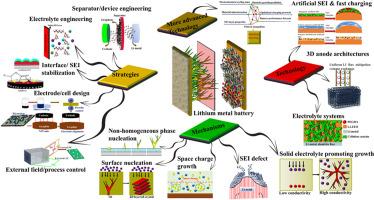Suppressing dendritic growth in lithium metal batteries: Recent strategies, mechanistic, and technological advances
IF 7.9
2区 工程技术
Q1 CHEMISTRY, PHYSICAL
引用次数: 0
Abstract
Lithium metal is considered the premier anode choice for high-energy-density batteries due to its exceptional theoretical capacity (3862 mAh g−1), remarkably low redox potential, and lightweight properties. The evolution of lithium metal electrodes represents a crucial step forward in realizing practical solid-state batteries. Nonetheless, lithium dendrite formation remains a major barrier, undermining both the longevity and safety and of lithium metal batteries (LMBs). This review examines recent strategies for suppressing lithium dendrites, focusing on mechanistic insights, electrolyte engineering, separator modifications, and advanced anode designs. High-concentration and solid-state electrolytes enhance interfacial stability, while artificial solid electrolyte interphase (SEI) layers and three-dimensional (3D) lithiophilic hosts promote uniform lithium (Li) deposition. External field-assisted techniques and optimized charging protocols further mitigate dendrite formation. Despite progress, challenges remain in scalability, cost, and full-cell integration. Advanced characterization and machine learning are essential for deeper mechanistic understanding and material optimization. Future research should prioritize multi-strategy synergies, scalable manufacturing, and real-world performance validation. Achieving dendrite-free LMBs requires interdisciplinary efforts to bridge fundamental science and industrial application, opening new avenues for high-performance energy storage in smart grids and electric vehicles. This review outlines current progress and future directions toward safe, high-performance LMBs for grid-scale and electric vehicles applications.

抑制锂金属电池的枝晶生长:最近的策略、机制和技术进展
锂金属由于其卓越的理论容量(3862毫安时g−1)、极低的氧化还原电位和重量轻的特性,被认为是高能量密度电池的首选阳极。锂金属电极的发展是实现实用化固态电池的关键一步。尽管如此,锂枝晶的形成仍然是锂金属电池(lmb)使用寿命和安全性的主要障碍。本文综述了最近抑制锂枝晶的策略,重点是机制见解,电解质工程,分离器修改和先进的阳极设计。高浓度和固态电解质增强了界面稳定性,而人工固体电解质界面(SEI)层和三维(3D)亲锂基质促进了均匀的锂(Li)沉积。外部现场辅助技术和优化的充电协议进一步减少了枝晶的形成。尽管取得了进展,但在可扩展性、成本和全单元集成方面仍然存在挑战。高级表征和机器学习对于更深入的机械理解和材料优化至关重要。未来的研究应优先考虑多战略协同效应、可扩展制造和现实世界的性能验证。实现无枝晶lmb需要跨学科的努力,桥梁基础科学和工业应用,为智能电网和电动汽车的高性能储能开辟新的途径。本文概述了用于电网规模和电动汽车的安全、高性能lmb的当前进展和未来方向。
本文章由计算机程序翻译,如有差异,请以英文原文为准。
求助全文
约1分钟内获得全文
求助全文
来源期刊

Journal of Power Sources
工程技术-电化学
CiteScore
16.40
自引率
6.50%
发文量
1249
审稿时长
36 days
期刊介绍:
The Journal of Power Sources is a publication catering to researchers and technologists interested in various aspects of the science, technology, and applications of electrochemical power sources. It covers original research and reviews on primary and secondary batteries, fuel cells, supercapacitors, and photo-electrochemical cells.
Topics considered include the research, development and applications of nanomaterials and novel componentry for these devices. Examples of applications of these electrochemical power sources include:
• Portable electronics
• Electric and Hybrid Electric Vehicles
• Uninterruptible Power Supply (UPS) systems
• Storage of renewable energy
• Satellites and deep space probes
• Boats and ships, drones and aircrafts
• Wearable energy storage systems
 求助内容:
求助内容: 应助结果提醒方式:
应助结果提醒方式:


